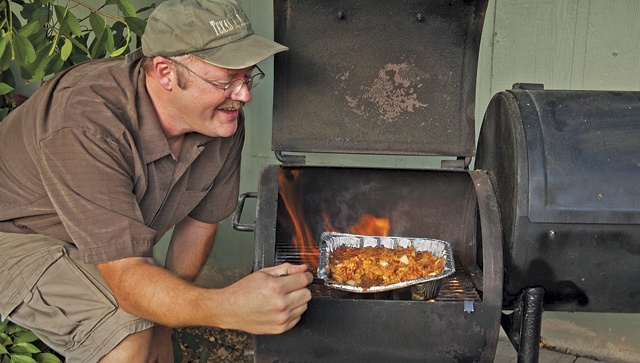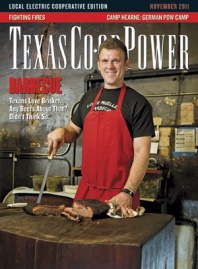When I decide to make barbecue, it can take a whole day for me to fire up the grill. Yes, I know how to make a fire, and, no, I don’t have to cut wood first. But every time I heat up my smoker, I want it to count.
So a barbecue for me begins at least a day before I actually put match to paper. There is meat to rub and marinate, sauce to simmer, side dishes to prepare. If I’m smoking chicken, I like to brine it first in a half-salt, half-sugar solution. This helps the meat stay tender and moist after a four-to-six-hour stay on my New Braunfels-style smoker.
This particular smoker design has an offset firebox attached to a larger smoking chamber. Dampers on the firebox and chimney allow me to control the intensity of the fire and the heat of the smoke: hotter for quicker-cooking meats, like chicken and sausage, and low and slow for bigger cuts like beef brisket or pork butt.
Over the years, I’ve learned that good barbecue can’t be rushed. A long, slow cooking time will yield the most flavorful and tender meat. So the night before the big meal, I build a big fire in my pit, burning down oak limbs into coals and adding a generous amount of charcoal. I’ll top that with a chunk or two of seasoned pecan or mesquite, then close the dampers and set the brisket or pork on indirect heat.
The fire smolders all night, keeping the heat low and even. Toward morning, the fire usually has burned down, but a new charge of charcoal and pecan wood takes care of that. My goal with large, fatty cuts of meat is to leave them on the smoker, fat side down, for at least 18 hours.
Then, throughout the day, depending on the size of crowd I’m feeding, the brisket will be joined by the chickens, sausage or whatever else I’m making—even some of the sides.
One of my sentimental favorite side-dish recipes is one for Barbecued Beans my dad used to make. He’d put the beans in an old ceramic pot with a lid, its glaze stained brown from years of smoke, and put it right on the grill. This dish uses relatively inexpensive ingredients, is easy to make (for easy cleanup, I put mine in a disposable foil pan) and can easily be doubled to feed a bigger crowd.
Barbecued Beans
2 cans (15 ounces each) ranch-style beans
2 cups shredded sharp Cheddar cheese
1 large onion, chopped
1 tablespoon Worcestershire sauce
1/4 cup barbecue sauce
6 ounces crushed corn chips (about 2 cups)
Stir together beans, cheese, onion and sauces. Add chips and mix well. Add more chips, if needed, to achieve a firm consistency. Put in fireproof container and cover. Place on indirect heat on smoker or grill and cook until heated through. If you’re using an oven, bake at 350 degrees for about 45 minutes.
Servings: 10. Serving size: 1/2 cup. Per serving: 308 calories, 12.1 g protein, 13 g fat, 33.9 g carbohydrates, 5.6 g dietary fiber, 1,052 mg sodium, 8.1 g sugars, 23 mg cholesterol
Cook’s Tip: Instead of buying fresh corn chips, save the stale remnants of corn or tortilla chips you already have. Add a bit more barbecue sauce if mixture seems too dry.


